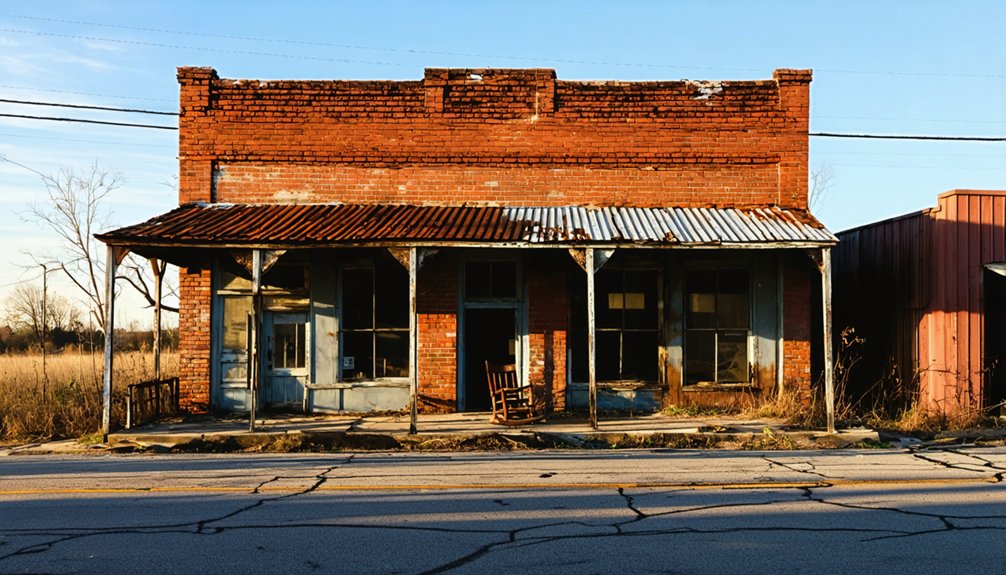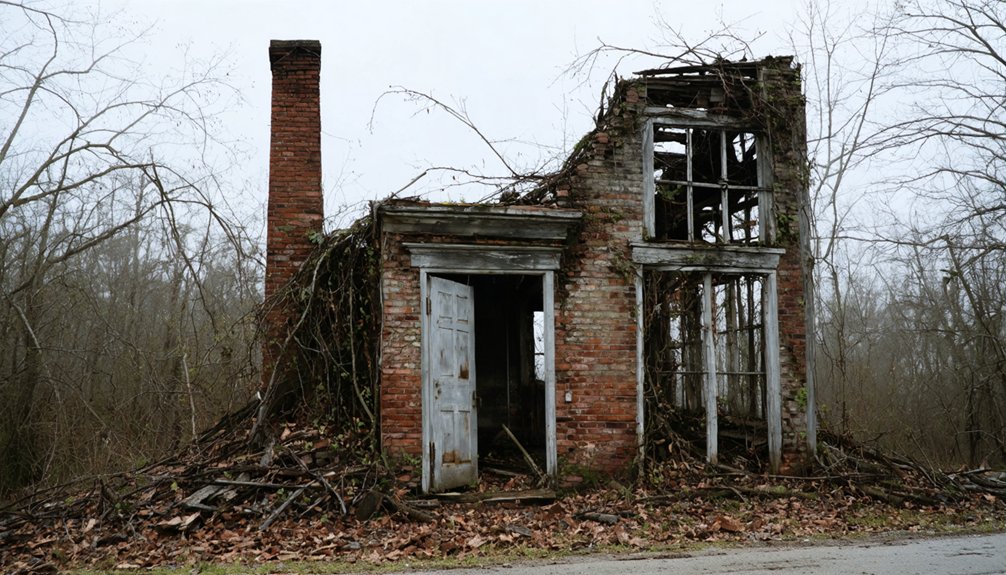You’ll find the ghost town of Nottingham tucked away in Alabama’s Talladega County, where it first emerged as Jones Camp Ground in the 19th century. This agricultural settlement featured general stores and churches as community hubs, with residents focusing on farming and timber harvesting. Though the town never fully developed and eventually faded due to economic shifts, its legacy lives on through archaeological discoveries, including Civil War era artifacts and historic maps that tell its forgotten story.
Key Takeaways
- Nottingham was originally known as Jones Camp Ground before becoming a ghost town in Talladega County, Alabama.
- The settlement emerged during the 19th century but failed to develop fully, eventually being overshadowed by nearby Talladega.
- Economic shifts and changes in transportation routes contributed to Nottingham’s decline and eventual abandonment.
- Archaeological discoveries include Civil War era artifacts, glass bottles, clay marbles, and metal objects found through detector surveys.
- Twenty-three historical maps dating back to 1890 document the settlement’s existence and development before its decline.
The Lost Settlement of Talladega County
Nestled in the heart of Talladega County, the ghost town of Nottingham stands as a tribute to Alabama’s ephemeral settlements.
You’ll find this forgotten “paper town” just one mile northeast of Talladega city, where only a handful of buildings were ever constructed. Originally known as Jones Camp Ground, Nottingham emerged during the 19th century but never achieved its intended growth.
Like many dreams of the Old South, Nottingham rose briefly from Jones Camp Ground only to fade back into Alabama’s wilderness.
As transport routes evolved and economic shifts reshaped the region, Nottingham faded into obscurity, overshadowed by more established neighboring towns like Talladega Superspeedway, which opened in 1969 and became a major regional landmark. Like Beaver Mills, the area saw significant changes during the Civil War period that affected its development.
Unlike other ghost towns in Alabama that thrived on mining or industry before their decline, Nottingham barely materialized beyond its initial planning stages.
Today, you can explore the remnants of this lost settlement through metal detecting and historic trails, uncovering traces of early Alabama’s ambitious development plans.
Historical Maps and Early Documentation
Today’s researchers can access twenty-three historic maps of Nottingham, offering a thorough window into this lost settlement’s physical layout and development.
You’ll find these maps particularly valuable for metal detecting and historical research, as they reveal property boundaries, landmarks, and possible locations of old homesites and commercial areas.
While the cartographic analysis shows Nottingham’s historical significance within Talladega County, you won’t find these maps readily available online.
The settlement appears in authoritative ghost town registries, but primary documentation like newspapers and land deeds requires deeper archival research.
Like many gold mining towns that dotted Alabama’s landscape, Nottingham experienced cycles of boom and bust that shaped its destiny.
For the most thorough information, you’ll need to visit local historical societies or county archives, where unpublished manuscripts, photographs, and oral histories may illuminate Nottingham’s early years and its role in Alabama’s frontier development.
The oldest available map dates back to 1890 Map of Talladega, providing crucial baseline documentation of the area’s early development.
Life in 19th Century Nottingham
While specific records of Nottingham’s population remain elusive, life in this 19th-century Alabama settlement mirrored the broader patterns of frontier development across the state.
You’d have found a stratified society where daily routines revolved around agricultural cycles and manual labor. The community centered around general stores, churches, and social gatherings like religious revivals. Similar to Britain’s Nottingham in the 1800s, the settlement saw significant growth during the Industrial Revolution period.
If you’d lived in Nottingham then, you’d have participated in a local economy based on mixed farming, timber harvesting, and bartering at the general store. Public health concerns were similar to those in British Nottingham, where a devastating cholera outbreak claimed 330 lives in 1832.
Your healthcare would’ve relied heavily on folk remedies, with trained physicians being scarce. Transportation was limited to wagons and riverboats, while education remained basic, especially for poor residents.
Like other Alabama settlements, community life included hunting, fishing, and storytelling as primary leisure activities.
Archaeological Discoveries and Artifacts
Archaeological excavations in Nottingham have yielded a rich array of artifacts from the early twentieth century, with some items dating back to the Civil War era.
Through careful artifact analysis and preservation techniques, you’ll discover a fascinating glimpse into daily life through these unearthed treasures:
- Glass bottles dominate the finds, including rare embossed poison bottles and medicinal containers from 1900-1930
- Wooden remains from old lumber mills feature tongue-and-groove boards, revealing industrial heritage
- Clay marbles and porcelain doorknobs tell stories of both children’s play and domestic life
- Local brick stamps, like those from Stevenson in Birmingham, connect to regional construction
- Metal artifacts, including buckles and industrial tags, emerge through metal detector surveys
The continuous dumping into the river created distinct layers, allowing archaeologists to date items through stratigraphic observation and associated finds.
A recent cleaning technique using acid bucket treatment has proven highly effective at removing decades of creek grime from recovered glass bottles.
Among the most notable medicinal discoveries was a Dr. Titner’s antiseptic bottle dating to the 1920s-30s, representing one of the earliest finds from the site.
Legacy and Modern Research Efforts
Despite its limited historical documentation, Nottingham’s legacy endures through modern research initiatives that combine traditional archival work with cutting-edge technological approaches.
You’ll find researchers using GIS mapping and digital repositories to piece together the town’s history, while local communities contribute valuable oral histories to ghost town preservation efforts. Similar to the preservation of Old Bellefonte Cemetery, Nottingham’s burial grounds serve as tangible links to its past inhabitants.
Academic institutions are spearheading collaborative projects between historians and archaeologists, creating extensive databases that track Alabama’s abandoned settlements.
While Nottingham lacks formal preservation initiatives compared to other ghost towns, you can access its story through historical maps and records maintained by local archives.
Through community involvement and technological integration, you’re witnessing a transformation in how researchers document and understand these forgotten places, ensuring their stories remain relevant for future generations.
Frequently Asked Questions
What Was the Peak Population of Nottingham During Its Most Active Period?
You won’t find reliable population figures for this ghost town’s peak, as historical records don’t document specific numbers. Like many small ghost towns experiencing population decline, its maximum size remains unknown.
Were There Any Notable Civil War Events or Battles in Nottingham?
Based on documented historical records, you won’t find any notable Civil War battles or military strategies that occurred in Nottingham, though Alabama itself saw significant wartime action throughout the conflict.
What Native American Tribes Originally Inhabited the Nottingham Area?
You’ll find the Cherokee, Creek, and Chickasaw tribes as the primary Native Tribes who shaped the cultural heritage of this area, with the Creek Confederacy having an especially strong presence.
Did Any Famous Historical Figures Have Connections to Nottingham?
You won’t find any famous residents or significant historical figures linked to Nottingham’s story. Unlike other Alabama ghost towns, it lacks documented connections to nationally or regionally prominent individuals in public records.
What Natural Disasters or Epidemics May Have Contributed to Nottingham’s Decline?
You can’t definitively attribute any natural calamities or disease outbreaks to Nottingham’s decline, as historical records don’t document specific disasters impacting this area during its 1880s-1890s period of abandonment.
References
- https://digitalalabama.com/alabama-ghost-towns/alabama-ghost-towns/9449
- https://ahc.alabama.gov/properties/cahawba/cahawba.aspx
- https://alabamabucketlist.com/ghost-towns-in-alabama/
- https://www.youtube.com/watch?v=Hcbb0-o2-f4
- https://freepages.history.rootsweb.com/~gtusa/usa/al.htm
- https://pastmaps.com/explore/us/alabama/talladega-county/nottingham/metal-detecting
- https://en.wikipedia.org/wiki/List_of_ghost_towns_in_Alabama
- https://www.southernspiritguide.org/alabama-hauntings-county-by-county-part-vii/
- https://digitalalabama.com/article/alabama-ghost-towns/page/3
- https://blog.batchgeo.com/ghost-towns/



